|
|
 |
Francois Joseph Heim
|
|
(16 December 1787 - 29 September 1865) was a French painter.
He was born at Belfort. He early distinguished himself at the École Centrale of Strassburg, and in 1803 entered the studio of Vincent at Paris. In 1807 he obtained the first prize, and in 1812 his picture of "The Return of Jacob" (Musee de Bordeaux) won for him a gold medal of the first class, which he again obtained in 1817, when he exhibited, together with other works, a St John--bought by Vivant Denon.
In 1819 the "Resurrection of Lazarus" (Cathedral Autun), the "Martyrdom of St Cyr" (St Gervais), and two scenes from the life of Vespasian (ordered by the king) attracted attention. In 1823 the "Re-erection of the Royal Tombs at St Denis," the "Martyrdom of St Laurence" (Nôtre Dame) and several full-length portraits increased the painter's popularity; and in 1824, when he exhibited his great canvas, the "Massacre of the Jews" (Louvre), Heim was rewarded with the Legion of Honour.
In 1827 appeared the "King giving away Prizes at the Salon of 1824" (Louvre--engraved by Jazet) the picture by which Heim is best known and "Saint Hyacinthe." Heim was now commissioned to decorate the Gallery Charles X (Louvre). Though ridiculed by the romantists, Heim succeeded Regnault at the Institute in 1834, shortly after which he commenced a series of drawings of the celebrities of his day, which are of much interest.
His decorations of the Conference room of the Chamber of Deputies were completed in 1844; and in 1847 his works at the Salon "Champ de Mai" and "Reading a Play at the Theâtre Français" were the signal for violent criticisms. Yet something like a turn of opinion in his favour took place at the exhibition of 1851; his powers as draughtsman and the occasional merits of his composition were recognized, and toleration extended even to his colour.
Heim was awarded the great gold medal, and in 1855--having sent to the Salon no less than sixteen portraits, amongst which may be cited those of Cuvier, Geoffroy de St Hilaire, and Madame Hersent he was made officer of the legion of honour. In 1859 he again exhibited a curious collection of portraits, sixty-four members of the Institute arranged in groups of four.
Besides the paintings already mentioned, there is to be seen in Nôtre Dame de Lorette (Paris) a work executed on the spot; and the museum of Strassburg contains an excellent example of his easel pictures, the subject of which is a Shepherd Drinking from a Spring.
cjr |
|
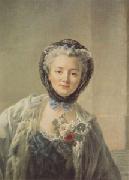 |
Francois-Hubert Drouais
|
|
Paris 1727-Rome 1775
was a French painter and Jean-Germain Drouais's father. He specialized in portraits, some of which include Louis XV's last two mistresses, Madame de Pompadour and Madame du Barry respectively. He even painted the young Marie Antoinette. |
|
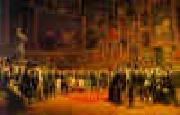 |
Francois-Joseph Heim
|
|
1787-1865
French Francois-Joseph Heim Gallery
He was born at Belfort. He early distinguished himself at the Ecole Centrale of Strassburg, and in 1803 entered the studio of Vincent at Paris. In 1807 he obtained the first prize, and in 1812 his picture of The Return of Jacob (Musee de Bordeaux) won for him a gold medal of the first class, which he again obtained in 1817, when he exhibited, together with other works, a St John-bought by Vivant Denon.
In 1819 the Resurrection of Lazarus (Cathedral Autun), the Martyrdom of St Cyr (St Gervais), and two scenes from the life of Vespasian (ordered by the king) attracted attention. In 1823 the Re-erection of the Royal Tombs at St Denis, the Martyrdom of St Laurence (Nôtre Dame) and several full-length portraits increased the painter popularity; and in 1824, when he exhibited his great canvas, the Massacre of the Jews (Louvre), Heim was rewarded with the Legion of Honour.
In 1827 appeared the King giving away Prizes at the Salon of 1824 (Louvre-engraved by Jazet) the picture by which Heim is best known and Saint Hyacinthe. Heim was now commissioned to decorate the Gallery Charles X (Louvre). Though ridiculed by the romantists, Heim succeeded Regnault at the Institute in 1834, shortly after which he commenced a series of drawings of the celebrities of his day, which are of much interest.
His decorations of the Conference room of the Chamber of Deputies were completed in 1844; and in 1847 his works at the Salon Champ de Mai and Reading a Play at the Theatre Francais were the signal for violent criticisms. Yet something like a turn of opinion in his favour took place at the exhibition of 1851; his powers as draughtsman and the occasional merits of his composition were recognized, and toleration extended even to his colour.
Heim was awarded the great gold medal, and in 1855-having sent to the Salon no less than sixteen portraits, amongst which may be cited those of Cuvier, Geoffroy de St Hilaire, and Madame Hersent he was made officer of the legion of honour. In 1859 he again exhibited a curious collection of portraits, sixty-four members of the Institute arranged in groups of four.
Besides the paintings already mentioned, there is to be seen in Notre Dame de Lorette (Paris) a work executed on the spot; and the museum of Strassburg contains an excellent example of his easel pictures, the subject of which is a Shepherd Drinking from a Spring. |
|
|
|
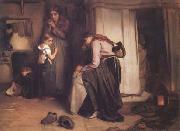 |
Frank Holl
|
|
1845-1888
Painter and illustrator. He received his first art instruction from his father, Francis Holl. At the age of 15 he entered the Royal Academy Schools, where in 1862 he was awarded a silver medal for drawing and in 1863 the gold medal for a religious subject, Abraham about to Sacrifice Isaac (untraced). In 1864 he exhibited two paintings at the Royal Academy, |
|
 |
Frans Hals
|
|
1580-1666
Frans Hals Galleries
In the field of group portraiture his work is equalled only by that of Rembrandt. Hals's portraits, both individual and group, have an immediacy and brilliance that bring his sitters to life in a way previously unknown in the Netherlands. This effect, achieved by strong Baroque designs and the innovative use of loose brushstrokes to depict light on form, was not to the taste of critics in the 18th century and the early 19th, when his work was characterized as lazy and unfinished. However, with the rise of Realism and, later, Impressionism, Hals was hailed as a modern painter before his time. Since then his works have always been popular. |
|
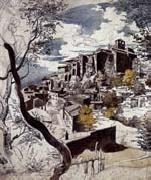 |
Franz Horny
|
|
German, 1798-1824,German painter. He received his first instruction in art from his father, Conrad Horny (1764-1807), a painter and copperplate engraver, who taught at the Zeichenschule in Weimar. He attended this school from 1806 to 1816, training primarily as a painter of landscapes. In 1816, his patron Baron Carl Friedrich von Rumohr, a friend of his father, enabled him to travel to Italy. In Rome Horny became a student of Joseph Anton Koch, who introduced him to landscape composition in the classically heroic style. Through eager study, both from nature and from live models, Horny's skills developed swiftly, especially in his work in pen and watercolour (e.g. View of Olevano with Shepherds and a Hermit, 1817; Dresden, Kupferstichkab.). Horny was soon, however, drawn into the circle of the Lukasbr?der: Peter Joseph Cornelius persuaded him to participate in the major fresco project for the Casino Massimo in Rome. Horny completed a large number of pen and watercolour drawings (e.g. Weimar, Schlossmus.) depicting flowers, fruit and birds, and intended as wreaths and festoons to frame Cornelius's historical scenes from Dante's Paradiso. When Cornelius was recalled to Munich in 1818, however, this fresco was not carried out and Horny's designs were therefore not used. In the same year, Horny developed tuberculosis and moved to Olevano for his health. The rugged beauty of the Sabine Hills and their picturesque towns drew him back to the depiction of landscape. His drawings, combining Koch's classically heroic outlook with the poetic sensibility of the Lukasbr?der, often convey the impression of an earthly paradise, as in Italian Country Life (c. 1820; L?beck, St Annen-Mus.). |
|
 |
Frederick Horsman Varley
|
|
(January 2, 1881 - September 8, 1969), was a member of the Canadian Group of Seven artists.
Varley was born in Sheffield, England. He studied art in Sheffield and in Belgium. He came to Canada in 1912 on the advice of another Sheffield native (and future Group of Seven member), Arthur Lismer, and found work at the Grip Ltd. design firm in Toronto, Ontario.
|
|
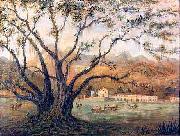 |
Friedrich Hagedorn
|
|
(23 April 1708 - 28 October 1754), German poet, was born at Hamburg, where his father, a man of scientific and literary taste, was Danish minister.
He was educated at the gymnasium of Hamburg, and later (1726) became a student of law at Jena. Returning to Hamburg in 1729, he obtained the appointment of unpaid private secretary to the Danish ambassador in London, where he lived till 1731. Hagedorn's return to Hamburg was followed by a period of great poverty and hardship, but in 1733 he was appointed secretary to the so-called "English Court" (Englischer Hof) in Hamburg, a trading company founded in the 13th century. He shortly afterwards married, and from this time had sufficient leisure to pursue his literary occupations till his death.
Hagedorn is the first German poet who bears unmistakable testimony to the nation's recovery from the devastation wrought by the Thirty Years' War. He is eminently a social poet. His light and graceful love-songs and anacreontics, with their undisguised joie de vivre, introduced a new note into the German lyric; his fables and tales in verse are hardly inferior in form and in delicate persiflage to those of his master La Fontaine, and his moralizing poetry re-echoes the philosophy of Horace. He exerted a dominant influence on the German lyric until late in the 18th century.
The first collection of Hagedorn's poems was published at Hamburg shortly after his return from Jena in 1729, under the title Versuch einiger Gedichte (reprinted by A. Sauer, Heilbronn, 1883). In 1738 appeared Versuch in poetischen Fabeln und Erzählungen; in 1742 a collection of his lyric poems, under the title Sammlung neuer Oden und Lieder; and his Moralische Gedichte in 1750. A collection of his entire works was published at Hamburg in 1757 after his death. The best is J.J. Eschenburg's edition (5 vols., Hamburg, 1800). Selections of his poetry with an excellent introduction in F. Muncker's Anakreontiker und preussisch-patriotische Lyriker (Stuttgart, 1894). See also H. Schuster, F. von Hagedorn und seine Bedeutung fer die deutsche Literatur (Leipzig, 1882); W. Eigenbrodt, Hagedorn und die Erzählung in Reimversen (Berlin, 1884).
|
|
|
|
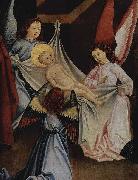 |
Friedrich Herlin
|
|
(c. 1425/30 - 1500) was a German painter. His earliest known work, depicting scenes from the Life of the Virgin, is dated 1459. A signature on an altarpiece in Nördlingen, dating it to 1462, identifies him as being from Rothenburg, as do citizenship documents from 1467. Nevertheless, it is possible that he lived there for only a short time, and that his origins lie in Ulm, where a painter named Hans Herlin lived and worked from 1449 until 1468. Stylistically, he borrowed much from Rogier van der Weyden, indicating a great deal of familiarity with the art of the Netherlands and of Cologne. The sculpture attached to the altarpiece of 1462, though officially listed as by the so-called "Master of Nördlingen", has been tentatively ascribed to Nicolaus Gerhaert, which if true would indicate extensive contacts to the highest artistic circles of the era.
Little else is known of Herlin, save that he died in Nördlingen in 1500.
|
|
|
|
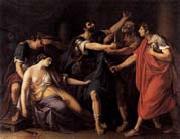 |
Gavin Hamilton
|
|
Scottish Neoclassical Painter, 1723-1798,Scottish painter, archaeologist and dealer, active in Italy. He was educated at Glasgow University and in 1748 arrived in Rome to study portrait painting under Agostino Masucci. He lodged with the architects James Stuart and Nicholas Revett; they probably encouraged him to visit Herculaneum and the recently discovered archaeological site of Pompeii, which had a profound effect on his subsequent career. Convinced that 'the ancients have surpassed the moderns, both in painting and sculpture', Hamilton undertook a systematic study of Classical antiquities during the 1750s and 1760s. In 1751 he was briefly in Scotland, where he painted a full-length portrait of Elizabeth Gunning, Duchess of Hamilton (Lennoxlove, Lothian), in a conventional style derived from van Dyck. He returned to Rome in 1752 and remained there, with the exception of short visits to England, for the rest of his life. In 1755 he was introduced by Anton Raphael Mengs to Johann Joachim Winckelmann, who was to become one of the leading theorists of Neo-classicism. In the same year Hamilton entertained Robert Adam, who studied in Rome from 1755 to 1757. He was to know and encourage almost all the British artists who worked in Rome during the second half of the 18th century. Henry Fuseli, who was not an uncritical admirer, wrote of Hamilton in 1805, |
|
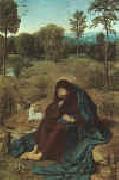 |
Geertgen Tot Sint Jans
|
|
Netherlandish Northern Renaissance Painter, ca.1460-1490
Geertgen tot Sint Jans is also known as Geertgen van Haarlem, Gerrit van Haarlem, or Gerrit Gerritsz.[citation needed] Alternative spellings of his first name are Gheertgen, Geerrit, and Gheerrit, where G(h)eertgen is the diminutive form of G(h)eerrit.
Presumably, he was born in Leiden, then in the Burgundian Netherlands in the Holy Roman Empire, around the year 1465. The assignment of Leiden as his birth place is traceable to a 17th century print by Jacob van Matham. There is no known archival evidence for this claim by Jacob van Matham. The modern acceptance of Leiden as Geertgen's birth place is roughly traceable to Johann Kessler's dissertation of 1930.
Probably, Geertgen was a pupil of Albert van Ouwater, who was one of the first oil painters in the northern Low Countries. Both painters lived in the city of Haarlem. Geertgen was attached to the monastery of the Knights of Saint John, for whom he painted an altarpiece. Although Geertgen was not a member of the Order of Saint John, his last name "tot Sint Jans" was derived from the order's name and means "unto Saint John".
Geertgen died in Haarlem, then the Habsburg Netherlands in the Holy Roman Empire, around the year 1495, when he was approximately 28 years old. He was buried in the monastery of the Knights of Saint John. Modern scholars have attempted to calculate the artist's death date with the information from The Painting-Book (Middle Dutch: Het Schilder-Boeck) by Karel van Mander, published in 1604. There are some archival traces that suggest he may in fact have lived into the 16th century. |
|
|
|
|
|
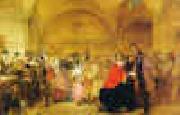 |
George Elgar Hicks
|
|
1824-1914
British
George Elgar Hicks Gallery
Born on March 13, 1824 in Lymington, Hampshire, George Elgar Hicks was the second son of a wealthy magistrate. His parents encouraged Hicks to become a doctor and so Hicks studied medicine at University College from 1840-42. However, after three years "ardous and disagreeable study" Hicks decided he wanted to be an artist. Due to this, Hicks began training as an artist considerably later in life than most artists of the time. In 1843, Hicks attended Sass's Academy and by 1844 had entered the Royal Academy Schools.
In 1847 Hicks married Maria Hariss and six of their eight children were born in the seven years following. He did not achieve much success as an artist during this period and later referred to his art at this time as "small and unimportant." He blamed this on the fact he had little time to study art or interact with other artists, due to his busy family life.
In 1859, Hicks painted his first large genre painting, Dividend Day. Bank of England (exhibited at the Royal Academy in 1859) following the success of Frith's paintings Ramsgate Sands and Derby Day at the Royal Academy. It was a typical genre painting, showing a scene from the Bank of England and featuring a broad range of social classes. Hicks painted several more large modern life paintings in the following years which were generally poorly reviewed by critics. These include The General Post Office. One minute to 6 (1860), Billingsgate Fish Market (1861) and Changing Homes (1862). Hicks paintings were often of subjects that no other artists attempted, such as the General Post Office and Billingsgate Fish Market. Hicks was one of the few artists that showed lasting interest in the emulation of Frith's style and is generally considered Frith's principal imitator.
By the late 1860s, the popularity of genre painting had waivered and Hicks began to focus on painting historical subjects, leading to society portraiture in the 1870s.
In 1884, Hicks remarried following the death of Maria in 1881. He retired in the 1890s and died a month before the declaration of World War I in 1914. |
|
|
|
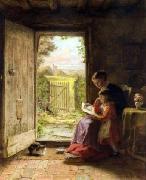 |
George Hardy
|
|
(1822-1909) was an English genre painter, a member of the Cranbrook Colony and eldest brother to Frederick Daniel Hardy.
Hardy was born in Brighton in Sussex the first son (of 8 children) of George Hardy (b. 1796 in London), a musician to George IV, Queen Adelaide, and Queen Victoria in the Royal household at Windsor. His mother was Sarah Lloyd (b. 1804).
Hardy became an oil painter of light-hearted genre subjects and moved to the artists' colony in Cranbrook in Kent. He married Ellen Hutton in May 1862 and the couple had 3 children.
Hardy died in Eastbourne in 1909.
|
|
 |
George Hayter
|
|
1792 - 1871
English painter and printmaker. He was the son of Charles Hayter (1761-1835), miniature painter, author of manuals for art instruction and Professor of Perspective and Drawing to Princess Charlotte. In 1808 George entered the Royal Academy Schools, and in 1815 was appointed Painter of Miniatures and Portraits by Princess Charlotte. Hayter was awarded the British Institution's premium for history painting for the Prophet Ezra (1815; Downton Castle, Heref. & Worcs), purchased by Richard Payne Knight. Encouraged by his patron, John Russell, 6th Duke of Bedford, he travelled to Italy to study in 1816, gaining election as an honorary member of the Accademia di S Luca in Florence. Returning to London in 1818, Hayter practised as a portrait painter in oils and history painter and occasionally acted as an art dealer. Dubbed 'The Phoenix' by William Beckford, Hayter showed a pomposity that irritated his fellow artists, but he mixed freely with many aristocratic families. |
|
|
|
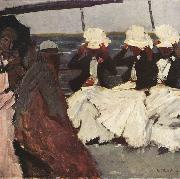 |
George Hendrik Breitner
|
|
Dutch Painter, 1857-1923
Dutch painter and photographer. He trained as a painter and draughtsman at the academy in The Hague. Although the Dutch painter Charles Rochussen taught the students history and landscape painting, Breitner's interests did not lie in this area. In 1880 he worked for a year in the studio of Willem Maris after his academy training. Maris belonged to the Hague school of painters, who worked in the plein-air tradition of the French Barbizon school. Breitner painted outdoor life with them, although it was not the picturesqueness of the landscape or the Dutch skies that appealed to him. With Van Gogh he roamed the working-class districts of The Hague and through the dockyards of Rotterdam. Both artists recorded the vitality of city life in their sketchbooks. Breitner consciously chose these themes and motifs: he wanted to paint people going about their daily lives |
|
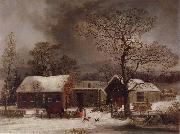 |
George Henry Durrie
|
|
American Painter, 1820-1863,American painter. Durrie and his older brother John (1818-98) studied sporadically from 1839 to 1841 with the portrait painter Nathaniel Jocelyn. From 1840 to 1842 he was an itinerant painter in Connecticut and New Jersey, finally settling permanently in New Haven. He produced c. 300 paintings, of which the earliest were portraits (e.g. Self-portrait, 1839; Shelburne, VT, Mus.); by the early 1850s he had begun to paint the rural genre scenes and winter landscapes of New England that are considered his finest achievement. His landscapes, for example A Christmas Party (1852; Tulsa, OK, Gilcrease Inst. Amer. Hist. & A.), are characterized by the use of pale though cheerful colours and by the repeated use of certain motifs: an isolated farmhouse, a road placed diagonally leading the eye into the composition, and a hill (usually the West or East Rocks, New Haven) in the distance. By the late 1850s Durrie's reputation had started to grow, and he was exhibiting at prestigious institutions, such as the National Academy of Design. In 1861 the firm of Currier & Ives helped popularize his work by publishing prints of two of his winter landscapes, |
|
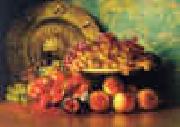 |
George Henry Hall
|
|
1825-1913
American painter. Brought up in Boston, he began his career as an artist at the age of 16. In 1849 he travelled with his friend Eastman Johnson to D?sseldorf. Hall studied at the K?nigliche Akademie for about a year, and after a further two years of study in Paris and Rome he returned in 1852 to New York where he settled. However, he remained an enthusiastic traveller and spent a total of more than 20 years abroad. |
|
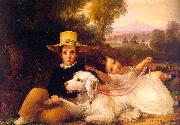 |
George Henry Harlow
|
|
British
1787-1819
He was born in St. James's Street, London, on 10 June 1787, the posthumous son of a China merchant, who after some years' residence in the East had died about five months before his son's birth, leaving a widow with five infant daughters. Indulged and petted by his mother, Harlow was sent when quite young to Dr. Barrow's classical school in Soho Square, and subsequently to Mr. Roy's school in Burlington Street. He was for a short time at Westminster School, but having shown a predilection for painting, he was placed under Henry De Cort, the landscape-painter. He next worked under Samuel Drummond, A.R.A., the portrait-painter, but after about a year entered the studio of Sir Thomas Lawrence, P.R.A. This step is said to have been taken at the suggestion of Georgiana, duchess of Devonshire; but Harlow's natural affinity to Lawrence's style in painting would be quite sufficient to account for his choice. Harlow paid Lawrence handsomely for his admission and the right to copy, but according to the contract was not entitled to instruction.
Harlow now determined to devote himself to painting, and refused an offer of a writership in the East India trade made by his father's friends. He remained for about eighteen months in Lawrence's studio, copying his pictures, and occasionally drawing preliminary portions of Lawrence's own productions. A difference about Harlow's work for one of Lawrence's pictures led to a breach with Lawrence, and Harlow rendered reconciliation impossible by painting a caricature signboard for an inn at Epsom in Lawrence's style and with Lawrence's initials affixed to it.
Harlow henceforth pursued an original system of art education. He inveighed strongly against all academical rules and principles. Young, headstrong, and impatient of restraint, with a handsome person and amiable disposition, he was generally popular in society. He affected, however, an extravagance in dress far beyond his means, a superiority of knowledge, and a license of conversation which gave frequent offence even to those really interested in the development of his genius. His foibles led his friends to nickname him "Clarissa Harlowe." He worked, however, with industry and enthusiasm in his art. He possessed a power of rapid observation and a retentive memory which enabled him to perform astonishing feats, like that of painting a satisfactory portrait of a gentleman named Hare, lately dead, whom Harlow had only once met in the street. Though openly opposed to the Royal Academy, he was a candidate for the dignity of academician, but he only received the vote of Henry Fuseli.
He exhibited for the first time at the Academy in 1804, sending a portrait of Dr. Thornton. In later years he exhibited many other portraits. His practice in this line was extensive. His portraits are well conceived, and, though much in the manner and style of Lawrence, have a character of their own. His portraits of ladies were always graceful and pleasing. He was less successful, owing to his defective art-education, in historical painting, in which he aspired to excel. His first exhibited historical pictures were Queen Elizabeth striking the Earl of Essex, at the Royal Academy, 1807, and The Earl of Bolingbroke entering London, at the British Institution, 1808.
In 1815 he painted Hubert and Prince Arthur for Mr. Leader, a picture subsequently exchanged for portraits of that gentleman's daughters. In 1814 he painted a group of portraits of Charles Mathews, the actor, in various characters, which attracted general attention. It was engraved by W. Greatbach for Yate's Life of Mathews. Harlow received a commission from Mr. Welch, the musician, to paint a portrait of Mrs. Siddons as Queen Katharine in Shakespeare's Henry VIII. This was commenced from memory, but subsequently the actress, at Mr. Welch's request, gave the painter a sitting. While painting the portrait, Harlow resolved to expand the picture into the "Trial Scene" from the same play, introducing portraits of the various members of the Kemble family and others. Mr. Welch, though not consulted by Harlow concerning this change of plan, behaved generously. The picture was exhibited at the Royal Academy in 1817, and excited great public interest. It was neither well composed nor well executed, and owed much to the criticism and suggestions of Fuseli, whose portrait Harlow was painting at the time. Still, the portrait of Mrs. Siddons herself as the queen will remain one of the most striking figures in English art. The fine engraving of it in mezzotint hy George Clint has enhanced its reputation. The picture passed eventually into the possession of Mr. Morrison at Basildon Park, Berkshire. It was exhibited at Manchester in 1857.
Harlow's next picture, The Virtue of Faith, at the Royal Academy, lacked originality, and had less success. It was purchased by his friend Mr. Tomkisson, who divided it into pieces for the sake of the heads.
In 1818 Harlow, conscious of deficiencies in his executive powers, visited Italy for the purpose of studying the old masters. At Rome his personal gifts and accomplishments, and his remarkable powers of execution, made him the hero of the day. He was f??ted and flattered in every direction. Canova was especially attracted by him, and obtained for him an introduction to the pope. Harlow, however, worked very hard, and completed a copy of Raphael's Transfiguration in eighteen days. He was elected a member for merit of the Academy of St. Luke at Rome, a most unusual distinction for an English artist, and was invited to paint his own portrait for the Uffizi gallery of painters at Florence. He painted a picture of Wolsey receiving the Cardinal's Hat in Westminster Abbey, and presented it to the Academy at Rome.
His artistic progress in Italy was remarkable, but on his return to England on 13 Jan. 1819 he was seized with a glandular affection of the throat, which being neglected proved fatal on 4 Feb. He was in his thirty-second year. He was buried under the altar of St. James's, Piccadilly, and his funeral was attended by the eminent artists of the day. An exhibition of his principal works was held in Pall Mall. His collections, including many sketches, were sold by auction 21 June 1819.
Harlow is one of the most attractive figures in the history of English painting. His works only suggest what lie might have achieved. Many of his portraits have been engraved, and those of James Northcote, Fuseli, Thomas Stothard, William Beechey, John Flaxman, and others are highly esteemed. His own portrait, painted by himself for the gallery at Florence, was engraved for Ranalli's Imperiale e Reale Galleria di Firenze. A drawing from it by J. Jackson, R.A., was bequeathed to the trustees of the National Portrait Gallery in 1888 by the painter's nephew, G. Harlow White. Another drawing by himself was engraved by B. Holl for the Library of the Fine Arts. His own portrait is introduced in the background in the picture of The Trial of Queen Katharine. A portrait of the Prince of Wales (afterwards George IV) by Harlow was engraved in mezzotint by W. Ward.
|
|
|
|
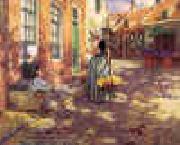 |
George Hitchcock
|
|
1850-1913
George Hitchcock (1850 - 1913), American artist, was born in Providence, Rhode Island.
Hitchcock graduated from the University of Manitoba, and from Harvard Law School in 1874. He then turned his attention to art and became a pupil of Gustave Boulanger and Jules-Joseph Lefebvre in Paris.
He attracted notice in the Paris Salon of 1885 with his "Tulip Growing", of a Dutch garden he painted in the Netherlands. For years he had a studio at Egmond-aan-Zee, in the Netherlands. He became a ch??valier of the French Legion of Honour; a member of the Vienna Academy of Arts, the Munich Secession Society, and other art bodies; and is represented in the Dresden gallery; the imperial collection in Vienna; the Chicago Art Institute, and the Detroit Institute of Arts. |
|
|
|
|
|
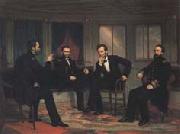 |
George P.A.Healy
|
|
American Painter, 1813-1894
American painter, active also in Europe. At the age of 17 he set up a studio in Boston after receiving encouragement from Thomas Sully, who was painting portraits there. Despite his youth and lack of training, he presented himself to the society figure Mrs Harrison Gray Otis and asked if he might paint her portrait (untraced); she agreed and later sponsored Healy's first trip abroad. In 1834 he entered the studio of Antoine-Jean Gros; the French master's suicide the following year ended Healy's only sustained period of artistic study. In Gros's studio he first encountered Thomas Couture, but they did not meet again until the next decade |
|
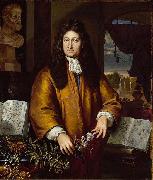 |
Gerard Hoet
|
|
(1648 - 1733), was a Dutch Golden Age painter.
Gerard Hoet trained with his father and brother who were glass painters, and Warnard van Rijsen, who lived in Zaltbommel, and who himself was a pupil of Cornelis van Poelenburgh in Utrecht. In 1672 Hoet moved to The Hague, but when the Count of Salis bought paintings at his mother's house in Zaltbommel, he returned to paint for him. He accompanied him to Rees, Germany, where he met the Utrecht painters Jan van Bunnik, Justus Nieuwpoort and Andries de Wit.With De Wit he returned to Utrecht, where he worked for Frederick Nassau de Zuylestein briefly before visiting the Hague and Amsterdam. He then travelled to France on the promise of a Marquis who wanted to give him a commission, but this promise falling through, he made some engravings of paintings by Francisque Millet.He then wanted to travel to England, but having written to his compatriot Lucas Vorsterman, he received word that there was more work to be had in Paris. Hoet travelled to Paris where he spent more than a year, before returning to the Netherlands via Brussels.In Brussels he met the painter Adriaen Frans Boudewyns, who convinced him to stay a while. After eight months, Hoet returned to Utrecht, where he worked for William Nassau de Zuylestein, 1st Earl of Rochford. He married and settled in Heemstede (Utrecht), where he found work for the lord of the castle there |
|
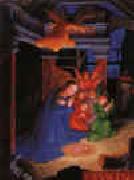 |
Gerard Hornebout
|
|
Flemish Northern Renaissance Painter and Manuscript Illuminator, ca.1465-1541 |
|
 |
Gerard van Honthorst
|
|
(November 4, 1592 - April 27, 1656), also known as Gerrit van Honthorst and Gherardo della Notte, was a Dutch painter of Utrecht. He was brought up at the school of Abraham Bloemaert, who exchanged the style of the Franckens for that of the pseudo-Italians at the beginning of the 16th century.
Margareta Maria de Roodere and Her Parents by Gerrit van Honthorst (1652) Oil on canvas, 140 x 170 cm. Centraal Museum, UtrechtInfected thus early with a mania which came to be very general in the Netherlands, Honthorst went to Italy in 1616, where he copied the naturalism and eccentricities of Michelangelo da Caravaggio. Home again about 1620, after acquiring a considerable practice in Rome, he set up a school at Utrecht which flourished exceedingly. Together with his colleague Hendrick ter Brugghen, he represented the so-called Dutch Caravaggisti. In 1623 he was president of his gild at Utrecht, where he had married his cousin. He soon became so fashionable that Sir Dudley Carleton, then English envoy at The Hague, recommended his works to the earl of Arundel and Lord Dorchester. In 1626 he received a visit from Rubens, whom he painted as the honest man sought for and found by Diogenes. |
|
|
|
|
|
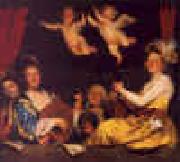 |
Gerrit van Honthorst
|
|
1590-1656
Dutch
Gerrit Van Honthorst Galleries
Gerard van Honthorst (November 4, 1592 - April 27, 1656), also known as Gerrit van Honthorst and Gherardo della Notte, was a Dutch painter of Utrecht. He was brought up at the school of Abraham Bloemaert, who exchanged the style of the Franckens for that of the pseudo-Italians at the beginning of the 16th century.
Margareta Maria de Roodere and Her Parents by Gerrit van Honthorst (1652) Oil on canvas, 140 x 170 cm. Centraal Museum, UtrechtInfected thus early with a mania which came to be very general in the Netherlands, Honthorst went to Italy in 1616, where he copied the naturalism and eccentricities of Michelangelo da Caravaggio. Home again about 1620, after acquiring a considerable practice in Rome, he set up a school at Utrecht which flourished exceedingly. Together with his colleague Hendrick ter Brugghen, he represented the so-called Dutch Caravaggisti. In 1623 he was president of his gild at Utrecht, where he had married his cousin. He soon became so fashionable that Sir Dudley Carleton, then English envoy at The Hague, recommended his works to the earl of Arundel and Lord Dorchester. In 1626 he received a visit from Rubens, whom he painted as the honest man sought for and found by Diogenes.
The queen of Bohemia, sister of Charles I of England and electress palatine, being in exile in the Netherlands, gave Honthorst her countenance and asked him to teach her children drawing; and Honthorst, thus approved and courted, became known to her brother Charles I, who invited him to England in 1628. There he painted several portraits, and a vast allegory, now at Hampton Court, of Charles and his queen as Diana and Apollo in the clouds receiving the duke of Buckingham as Mercury and guardian of the king of Bohemia's children. Charles I, whose taste was flattered alike by the energy of Rubens and the elegance of Van Dyck, was thus first captivated by the fanciful mediocrity of Honthorst, who though a poor executant had luckily for himself caught, as Lord Arundel said, much of the manner of Caravaggio's colouring, then so much esteemed at Rome. |
|
|
|
|
|
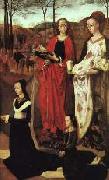 |
GOES, Hugo van der
|
|
Netherlandish Northern Renaissance Painter, ca.1440-1482
South Netherlandish painter. In 1467 he enrolled as master in the Ghent painters' guild, sponsored by Joos van Wassenhove, master painter in Ghent in 1464 after registering in Antwerp in 1460. In 1469 the two together acted as guarantors for the illuminator Sanders Bening when he became a master, and it was from Hugo that Joos borrowed money when he went to Rome. Sanders Bening was married to Kathelijn van der Goes, perhaps Hugo's sister. Hugo's status within the guild is further attested by the fact that he was guarantor for two other painters in 1471 and 1475, that he was one of the dean's jurors in 1468-9 and that he himself served as dean from towards the end of 1473-4 to at least 18 August 1475. |
|
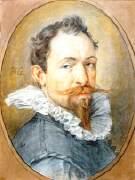 |
GOLTZIUS, Hendrick
|
|
Dutch Baroque Era Painter and Engraver, 1558-1617
Dutch draughtsman, printmaker, print publisher and painter. He was an important artist of the transitional period between the late 16th century and the early 17th, when the conception of art in the northern Netherlands was gradually changing. Goltzius was initially an exponent of Mannerism, with its strong idealization of subject and form. Together with the other two well-known Dutch Mannerists, Karel van Mander I and Cornelis Cornelisz. van Haarlem, he introduced the complex compositional schemes and exaggeratedly contorted figures of Bartholom?us Spranger to the northern Netherlands. These three artists are also supposed to have established an academy in Haarlem in the mid-1580s, but virtually nothing is known about this project. In 1590 Goltzius travelled to Italy, thereafter abandoning Spranger as a model and developing a late Renaissance style based on a broadly academic and classicizing approach. Later still, his art reflected the growing interest in naturalism that emerged in the northern Netherlands from c. 1600. |
|
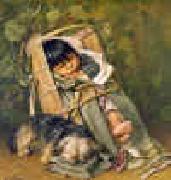 |
Grace Carpenter Hudson
|
|
1865-1937
Grace Carpenter Hudson Galleries
Grace Carpenter Hudson (1865 - 1937) was an American painter. She was nationally known during her lifetime for a numbered series of more than 684 portraits of the local Pomo Indians. She painted the first, "National Thorn", after her marriage in 1891, and the last in 1935.
Grace Carpenter was born in Potter Valley, California. Her mother was one of the first white school teachers educating Pomo children and was a commercial portrait photographer in Ukiah, California; her father was a skilled panoramic and landscape photographer who chronicled early Mendocino County frontier enterprises such as logging, shipping and railroading.[1] At fourteen years of age, Grace was sent to attend the recently-established San Francisco School of Design, an art school which emphasized painting from nature rather than from memory or by copying existing works. At sixteen, she executed an award-winning, full length, life sized self-portrait in crayon. While in San Francisco, she met and eloped with a man fifteen years her senior named William Davis, upsetting her parents and ending her formal studies. The marriage lasted only a year.
From 1885 to 1890, Grace Carpenter Davis lived with her parents in Ukiah painting, teaching and rendering illustrations for magazines such as Cosmopolitan and Overland Monthly. Her work at that time had no particular focus and included genre, landscapes, portraits and still lifes in all media. Later in her career she would continue to accept occasional magazine illustration assignments including ones for Sunset. |
|
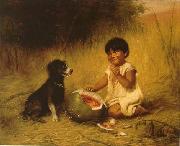 |
Grace Hudson
|
|
(1865 - 1937) was an American painter. She was nationally known during her lifetime for a numbered series of more than 684 portraits of the local Pomo Indians. She painted the first, "National Thorn", after her marriage in 1891, and the last in 1935.
Grace Carpenter was born in Potter Valley, California. Her mother was one of the first white school teachers educating Pomo children and was a commercial portrait photographer in Ukiah, California; her father was a skilled panoramic and landscape photographer who chronicled early Mendocino County frontier enterprises such as logging, shipping and railroading. At fourteen years of age, Grace was sent to attend the recently-established San Francisco School of Design, an art school which emphasized painting from nature rather than from memory or by copying existing works. At sixteen, she executed an award-winning, full length, life sized self-portrait in crayon. While in San Francisco, she met and eloped with a man fifteen years her senior named William Davis, upsetting her parents and ending her formal studies. The marriage lasted only a year.
From 1885 to 1890, Grace Carpenter Davis lived with her parents in Ukiah painting, teaching and rendering illustrations for magazines such as Cosmopolitan and Overland Monthly. Her work at that time had no particular focus and included genre, landscapes, portraits and still lifes in all media. Later in her career she would continue to accept occasional magazine illustration assignments including ones for Sunset.
|
|
|
|
 |
Gustav Adolph Hennig
|
|
Gustav Adolph Hennig (1797-1869)Professions: Historical-scenes painter; Porträtmaler; Miniature painter; Etcher; Lithographer. |
|
|
|
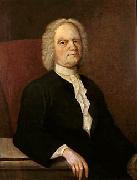 |
Gustavus Hesselius
|
|
(1682 - May 25, 1755) was a Swedish born painter who emigrated to the New World in 1711. He was the father of painter John Hesselius and cousin of the religious leader Emanuel Swedenborg.
Hesselius left his home country of Sweden for Wilmington, Delaware in 1711. There he lived until 1717 when he moved to Philadelphia, Pennsylvania, where he lived until 1721. In 1721, he moved to Prince George's County, Maryland and became a portrait painter, though he had been trained in Sweden. That same year, he received the first recorded public art commission in the American colonies, he painted The Last Supper. He also painted a Crucifixion. Some time around 1735, Hesselius returned to Philadelphia where spent the rest of his life and traveling. He was listed as a member of the Gloria Dei (Old Swedes') Church in Philadelphia.
He also worked as an organ builder, having built an organ for the Moravian Church in Bethlehem, Pennsylvania in 1746. From about this time on, he focused on building organs, referring painting commissions to his son John.
J. Hall Pleasants has said that Hesselius became "America's earliest portrait painter of note." In 1994 he was named to the Prince George's County Hall of Fame.
|
|
|
|
|
|
|
|
|
|
|

